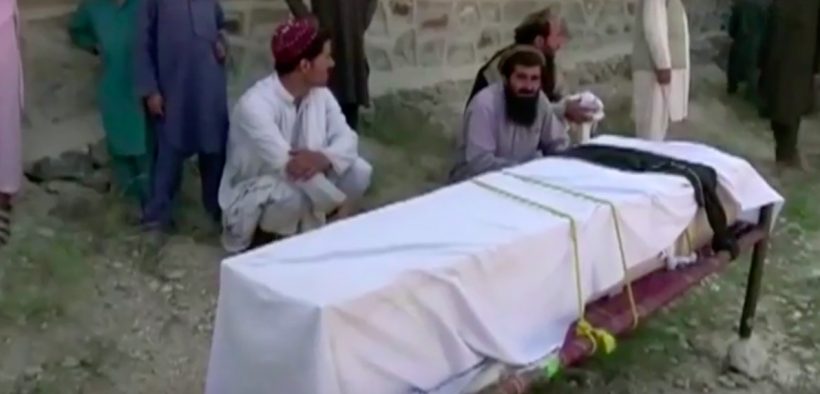US Drone Strike Kills 30 Pine Nut Farmers In Afghanistan

“My son and his friends were killed by the Americans. How could they do this to us?”
A U.S. drone strike killed 30 farmers and workers in Afghanistan’s Nangarhar province who were resting after harvesting pine nuts late last Wednesday, injuring at least 40 more. The U.S. and Afghani government have confirmed the air strike, saying it was meant to hit ISIS targets. The news comes in the wake of escalated Taliban violence after the collapse of US peace talks, with insurgents vowing to target the Afghan election next week to intimidate voters away from polling stations.
“US forces conducted a drone strike against Da’esh [Isis] terrorists in Nangarhar,” said Col Sonny Leggett, a spokesman for U.S. forces in Afghanistan. “We are aware of allegations of the death of non-combatants and are working with local officials to determine the facts.”
Taliban and Islamic State fighters have been struggling over Nangarhar’s mineral-rich natural resources, prompting the U.S. and Afghan forces to launch regular air strikes in an effort to retake the now mostly jihadist-controlled territory.
“There were IS (fighters) there, but it appears during harvest season the locals cut deals with the IS fighters to act as harvesters,” a senior U.S. official told Reuters a few days later. “We were not privy to this ‘agreement’ that puts them (IS fighters) amongst other harvesters. We are working through it now with the officials.”
The Reuters team who first reported the situation found that village elders of the area in question sent a letter to the province’s governor on September 7, urging the US-backed government forces to take measures to protect the farm laborers from air strikes. Reuters reported that the local residents were shocked and infuriated by the attack, which was carried out despite assurance from the Afghan government that they would be protected.
“The warring sides had given their consent and contractors were hired to bring in laborers from neighboring provinces … no illegal activity was being pursued, but even then, the U.S. drone killed innocent people,” Sohrab Qadri, a member of the Nangarhar provincial council, told Reuters.
“My son and his friends were killed by the Americans,” said Malak Khaiyali Khan, a local village leader whose teenage son and his three friends were among the children killed by the strike. “How could they do this to us?”
“Such mistakes cannot be justified. American forces must realize (they) will never win the war by killing innocent civilians,” Javed Mansur, a resident of Jalalabad city, told Reuters.
The misfired drone strike came a day before a botched Taliban truck bombing killed 39 medical workers and patients at a hospital in Afghanistan’s Zabul province. The Taliban admitted responsibility for the civilian deaths, saying they failed to hit their intended target, a government intelligence office next to the office.
The Situation In Afghanistan
Earlier this month, the percentage of Afghans who described their life situation as “suffering” reached 85%, the highest amount recorded since Gallup began surveying public well-being. Of the respondents, most of whom were 35 or younger, 52% said they felt worry for much of the previous day, an increase from 42% in 2016. Only 36% of respondents said they laughed or smiled the previous day, another record for Gallup.
An estimated 16,000 civilians have died in Afghanistan during the last 10 years, according to the United Nations. Civilian deaths hit a record high in 2018, and the Afghan government and U.S. forces killed more civilians than the Taliban in the first six months of 2019.
Gallup attributes Afghanistan’s status as the most miserable country in the world to the lack of safety and security and the inability to repair infrastructure that would allow the population to improve their economic well-being. Pine nut harvesting presents a rare economic opportunity for Afghanis, who export up to $800 million worth of the crop to China every year through an air corridor, as per Reuters.
ISIS, while diminished in Syria and Iraq, has gained strength in Afghanistan, with an estimated 2,000 fighters in the country. The village elders had received assurance from ISIS leaders as well as the Afghani government that pine nut workers would be safe from the skirmishes. Al-Qaeda similarly holds a formidable presence with nearly 240 fighters in the country, according to the U.N. Security Council.
The deteriorating state of the 18-year conflict has motivated 2020 Democratic presidential candidates like Rep. Tulsi Gabbard to say they would reengage peace talks and withdraw American forces. More than 2,400 Americans have lost their lives in Afghanistan since the 2001 invasion, and nearly a trillion in taxpayer dollars has been spent on the war. “We’re pretty close to the day when we will wake up to the news of a casualty in Afghanistan who was not born on 9/11,” said South Bend Mayor Pete Buttigieg, a veteran of Afghanistan, at the CNN presidential debate.
The Intercept’s Mehdi Hasan argues that if former President Obama’s 100,000 troop surge in Afghanistan couldn’t defeat the Taliban in 2011, the current deployment of 14,000 US troops has no hope of overcoming the group in the foreseeable future. The Taliban now controls nearly half the country.
The Observer’s editorial board, on the other hand, argues that “by invading, occupying and seeking to control Afghanistan, the US made itself responsible for its future,” and that America can not look away at a time when the country’s beleaguered democracy is on the brink of collapse.
Since President Trump canceled peace talks earlier this month, the Taliban has been carrying out almost daily attacks to retaliate against the United States and intimidate voters before the presidential election next week. The US cut $160m in direct funding to Afghanistan last week, citing the country’s failure to manage corruption, but some analysts viewed it as retribution for Afghani President Ashraf Ghani’s criticism of Trump’s abrupt withdrawal from peace talks.
















The bottom line: Pine-nut futures were slightly up, then came down again. The market is steadied.
Next subject!